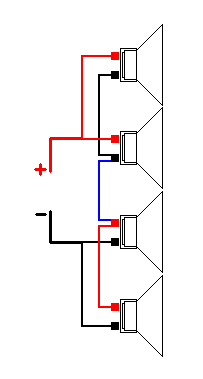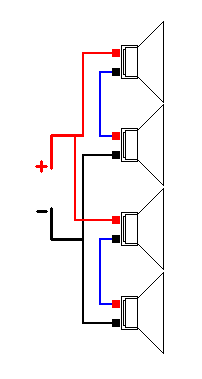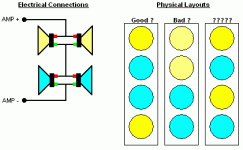Hello Friends!
My current project is a pair of full-range speakers. I have two 20watt SE class-A amps which will drive them. I searched for 15-20watt full-ranges in my area but found nothing. The only available ones are of 30watt, but, are 8"! My liking is in the range of 4"-6". There are 4" drivers available, are of 8ohm impedance, but have a mere 5watt maximum power handling. My amp is happiest with a 8ohm of load impedance. So I decided to connect 4 of the drivers to each amp in Series-Parallel configuration resulting in 8ohm total impedance.
My question is that which connection technique should I choose? Which Of the following would be better?
Left or right?
 ........OR........
........OR........

I have listened to both, but did not hear any difference in sound quality. I would like to interconnect the drivers in both channels in physically identical ways, i.e. will use any one of the two configs for both channels.
So any information about any objective advantage/disadvantage of either configuration is very much appreciated.
Thanks
.
My current project is a pair of full-range speakers. I have two 20watt SE class-A amps which will drive them. I searched for 15-20watt full-ranges in my area but found nothing. The only available ones are of 30watt, but, are 8"! My liking is in the range of 4"-6". There are 4" drivers available, are of 8ohm impedance, but have a mere 5watt maximum power handling. My amp is happiest with a 8ohm of load impedance. So I decided to connect 4 of the drivers to each amp in Series-Parallel configuration resulting in 8ohm total impedance.
My question is that which connection technique should I choose? Which Of the following would be better?
Left or right?
I have listened to both, but did not hear any difference in sound quality. I would like to interconnect the drivers in both channels in physically identical ways, i.e. will use any one of the two configs for both channels.
So any information about any objective advantage/disadvantage of either configuration is very much appreciated.
Thanks
.
With series connection of two speakers ,except the doubling of impedance and the output level (And a double efficiency)=,nothing changes .Paralleling two speakers ,it halves the impedance ,doubles sensitivity and output . With serial-parallel connection impedance remains the same , but you get 4 times output level ,which is +12dB,same rise of efficiency(+6dB-1W) ,and same change in sensitivity ,+6dB with 2,83 V.
?
Thanks for your response. But I doubt this answers my question.
Experts please help. Thanks for your time.
.
With series connection of two speakers ,except the doubling of impedance and the output level (And a double efficiency)=,nothing changes .Paralleling two speakers ,it halves the impedance ,doubles sensitivity and output . With serial-parallel connection impedance remains the same , but you get 4 times output level ,which is +12dB,same rise of efficiency(+6dB-1W) ,and same change in sensitivity ,+6dB with 2,83 V.
Thanks for your response. But I doubt this answers my question.
Experts please help. Thanks for your time.
.
Apart from the fact that the pictures you've made are pretty unreadable-undetectable , I suggest you to try both configurations,ie //per pair then two pairs in series ,or series of two // pairs , and I'm not even sure that is the optimal solution , specially when you put in series two coils ,don't know what exactly happens in terms of distortions. I tried a dipole in push-pull with two drivers in series ,and the drum attack is remarkable !
Bye
Bye
The answer is that either way of wiring gives exactly the same result of impedance, Qts, Fs, efficiency, everything.
But for safety sake the best way is to wire two drivers in series, then connect the pair in parallel to another series connected pair. This way ensures that if a driver goes open circuit due to over powering the voice coil then the other paired driver gets cut off so is less likely to get damaged also.
But for safety sake the best way is to wire two drivers in series, then connect the pair in parallel to another series connected pair. This way ensures that if a driver goes open circuit due to over powering the voice coil then the other paired driver gets cut off so is less likely to get damaged also.
Hi all,
The best sound quality connection is parallel by a mile, but you should get four 16 ohms speakers for a final impedance of 4 ohms (16ohms/4drivers=4ohms).
The second best is parallel-serie, that is not show in your drawer, the calc is (16ohms/2speaker=8ohms, plus 16ohms/2speakers=8ohms then 8+8=16ohms). For four 8ohms speakers is (8/2=4) + (8/2=4) so (4+4=8ohms)
The worse sound is the serie connection, but in Pro Sound it is used, the speaker impedance is added (4+4+4+4=16 ohms).
As I like line arrays Iam over this issue much years, for my dismay according Scottmoose and others experts in this Site, various FR will have problems of frequency anomaly(comb filter effect etc) see page four at: http://www.diyaudio.com/forums/full...lpair-12-full-range-driver-mark-fenlon-4.html
Good Luck, Gustavo
P.S.: Please, inform us about the sound results of your experiment in the future.
The best sound quality connection is parallel by a mile, but you should get four 16 ohms speakers for a final impedance of 4 ohms (16ohms/4drivers=4ohms).
The second best is parallel-serie, that is not show in your drawer, the calc is (16ohms/2speaker=8ohms, plus 16ohms/2speakers=8ohms then 8+8=16ohms). For four 8ohms speakers is (8/2=4) + (8/2=4) so (4+4=8ohms)
The worse sound is the serie connection, but in Pro Sound it is used, the speaker impedance is added (4+4+4+4=16 ohms).
As I like line arrays Iam over this issue much years, for my dismay according Scottmoose and others experts in this Site, various FR will have problems of frequency anomaly(comb filter effect etc) see page four at: http://www.diyaudio.com/forums/full...lpair-12-full-range-driver-mark-fenlon-4.html
Good Luck, Gustavo
P.S.: Please, inform us about the sound results of your experiment in the future.
Last edited:
Hi All,
The best sound quality connection is parallel by a mile, but you should get four 16 ohms speakers for a final impedance of 4 ohms (16ohms/4drivers=4ohms).
Which will then have different Qts and possibly Fs, so you cannot make a valid comparison.
Apart from the fact that the pictures you've made are pretty unreadable-undetectable , I suggest you to try both configurations,ie //per pair then two pairs in series ,or series of two // pairs , and I'm not even sure that is the optimal solution , specially when you put in series two coils ,don't know what exactly happens in terms of distortions. I tried a dipole in push-pull with two drivers in series ,and the drum attack is remarkable !
Bye
I know what happens when one puts two coils in series, it worsens high frequencies(double the impedance). I am with full ranges here.
Making things clear(er). Red= +ve Black= -ve. But that info is already there. I'm just making things readable. The rest of the fact is unimportant.
thanks.
Looks you are thinking this parameters will suffers alterations. By what I know only the CMS may add If the box volume is small for the driver.Which will then have different Qts and possibly Fs, so you cannot make a valid comparison.
The answer is that either way of wiring gives exactly the same result of impedance, Qts, Fs, efficiency, everything.
But for safety sake the best way is to wire two drivers in series, then connect the pair in parallel to another series connected pair. This way ensures that if a driver goes open circuit due to over powering the voice coil then the other paired driver gets cut off so is less likely to get damaged also.
I see. Thanks for the information.
Last edited:
Hi all,
The best sound quality connection is parallel by a mile, but you should get four 16 ohms speakers for a final impedance of 4 ohms (16ohms/4drivers=4ohms).
The second best is parallel-serie, that is not show in your drawer, the calc is (16ohms/2speaker=8ohms, plus 16ohms/2speakers=8ohms then 8+8=16ohms). For four 8ohms speakers is (8/2=4) + (8/2=4) so (4+4=8ohms)
The worse sound is the serie connection, but in Pro Sound it is used, the speaker impedance is added (4+4+4+4=16 ohms).
As I like line arrays Iam over this issue much years, for my dismay according Scottmoose and others experts in this Site, various FR will have problems of frequency anomaly(comb filter effect etc) see page four at: http://www.diyaudio.com/forums/full...lpair-12-full-range-driver-mark-fenlon-4.html
Good Luck, Gustavo
P.S.: Please, inform us about the sound results of your experiment in the future.
Looking at the first picture(added below), I see two clear Parallel circuits(pink and green square) are connected by a single wire(blue) to form a series connection between the pairs. So I think it is Parallel-Series.
And the resulting impedance for both configs is 8ohm.
Thanks for the information.
Hi Shaan:
This image could be is a Parallel-Serie If you remove the blue link between the 2º and the 3º speaker, this is a error and seems a simple serie connection partial link.
Iam referring a connection au contraire of this image, two drivers are linked in parallel and more two drivers again, after this two sets are linked in serie.
This image could be is a Parallel-Serie If you remove the blue link between the 2º and the 3º speaker, this is a error and seems a simple serie connection partial link.
Iam referring a connection au contraire of this image, two drivers are linked in parallel and more two drivers again, after this two sets are linked in serie.
This is a plain Serie connection.
An externally hosted image should be here but it was not working when we last tested it.
A pure parallel connection:
An externally hosted image should be here but it was not working when we last tested it.
This is a Parallel-Serie connection, good for keep the same impedance, sound quality not as good as a pure parallel etc...
This green line in the middle addition the two sets impedances. You could do this connection for 4 drivers of 8 ohms etc
This green line in the middle addition the two sets impedances. You could do this connection for 4 drivers of 8 ohms etc
An externally hosted image should be here but it was not working when we last tested it.
Last edited:
Hi Shaan
I vote for the one on the left (repeated in your post #9).
In theory both schematics give identical results but in real life the drivers will not be identical.
The main issue is if you take two drivers with different resonant frequencies and connect them in series, there will be a small frequency range where the cones tend to move out of phase with each other - high driver excursion without matching output. This is a accompanied by a big peak in impedance.
Connecting the 2 in parallel forces them to work together in a more coordinated fashion and gives much better damped impedance hump.
I'd prefer a series connection of 2 well damped parallel-connected pairs to a parallel connection of two badly-behaved series-connected pairs.
Hope all of the above makes some sense - I'm up to my eyeballs in painkillers right now (and they're not f***ing working either
 ) - so struggling to be coherent.
) - so struggling to be coherent.
Cheers - Godfrey
p.s. half agree with richie00boy about safety, but I'm assuming you're not planning to blow them one at a time anyway.
I vote for the one on the left (repeated in your post #9).
In theory both schematics give identical results but in real life the drivers will not be identical.
The main issue is if you take two drivers with different resonant frequencies and connect them in series, there will be a small frequency range where the cones tend to move out of phase with each other - high driver excursion without matching output. This is a accompanied by a big peak in impedance.
Connecting the 2 in parallel forces them to work together in a more coordinated fashion and gives much better damped impedance hump.
I'd prefer a series connection of 2 well damped parallel-connected pairs to a parallel connection of two badly-behaved series-connected pairs.
Hope all of the above makes some sense - I'm up to my eyeballs in painkillers right now (and they're not f***ing working either
Cheers - Godfrey
p.s. half agree with richie00boy about safety, but I'm assuming you're not planning to blow them one at a time anyway.
I afraid it is not, the image on post 11 is a plain serie connecion more a few links, that are a mess in this image context, maybe is a typo or a test of some engineer/book etc, could work or made a blast.Hi Gustavo
Agree with your posts except Shaans first diagram is the same as your parallel-series diagram. The blue wire on Shaan's diagram is the same as the green wire on your diagram, isn't it?
Cheers - Godfrey
The last image I made is a (parallel + Serie + Parallel) or (8ohm/2drivers=4ohms)+(8ohms/2drivrs=4) so 4+4=8ohms.
Hello Godfrey,Hi Gustavo
Agree with your posts except Shaans first diagram is the same as your parallel-series diagram. The blue wire on Shaan's diagram is the same as the green wire on your diagram, isn't it?
Cheers - Godfrey
I put the Shaan image on post 11 in this combo with my image. Please Note, the dashed brown line.
An externally hosted image should be here but it was not working when we last tested it.
Hmm ....
Maybe we can agree on this wiring diagram - redrawn with no wires crossing over?
And now for something different to argue about - the physical layout:
Each driver will be affected by how close to the floor it is, so maybe it's bad for one parallel pair to be close to the floor, and the other pair at the top (see "bad" example).
From that point of view, the "good" example would be better - with the top and bottom drivers in parallel and the middle two in parallel.
Or maybe the third pattern where they alternate?

My guess is it won't make much difference anyway, but may be worth thinking about.
Maybe we can agree on this wiring diagram - redrawn with no wires crossing over?
And now for something different to argue about - the physical layout:
Each driver will be affected by how close to the floor it is, so maybe it's bad for one parallel pair to be close to the floor, and the other pair at the top (see "bad" example).
From that point of view, the "good" example would be better - with the top and bottom drivers in parallel and the middle two in parallel.
Or maybe the third pattern where they alternate?
My guess is it won't make much difference anyway, but may be worth thinking about.
Attachments
- Status
- This old topic is closed. If you want to reopen this topic, contact a moderator using the "Report Post" button.
- Home
- Loudspeakers
- Full Range
- Series-Parallel Or Parallel-Series
